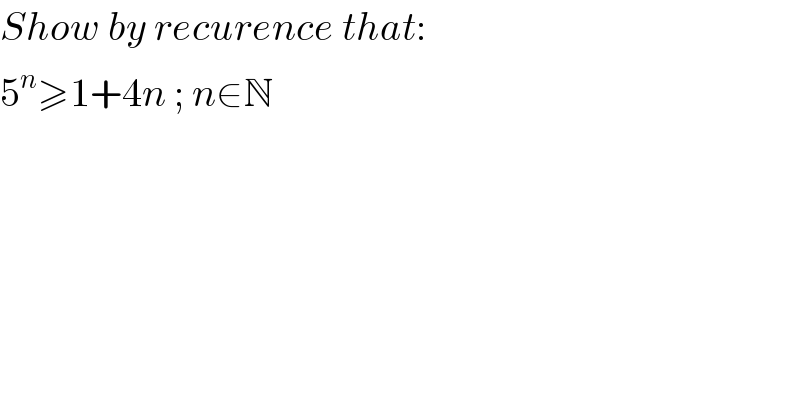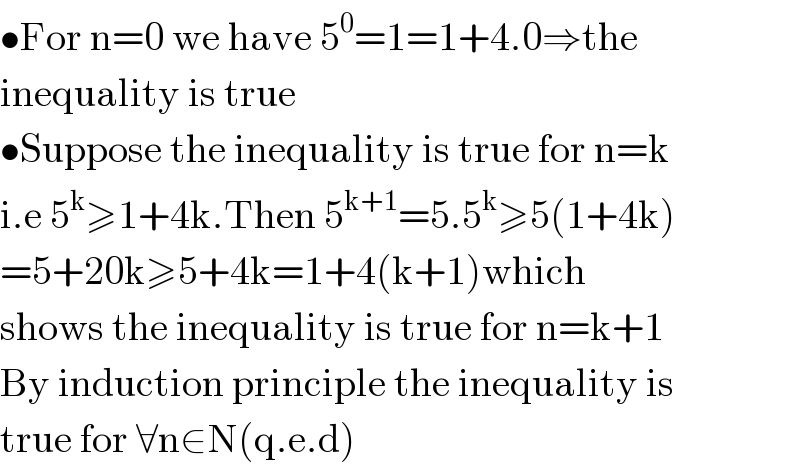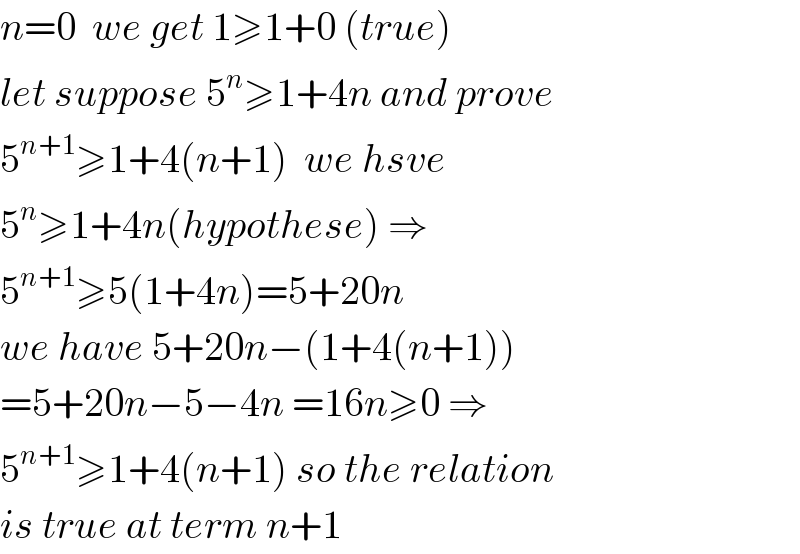Question Number 119054 by mathocean1 last updated on 21/Oct/20

$${Show}\:{by}\:{recurence}\:{that}: \\ $$$$\mathrm{5}^{{n}} \geqslant\mathrm{1}+\mathrm{4}{n}\:;\:{n}\in\mathbb{N} \\ $$
Answered by 1549442205PVT last updated on 22/Oct/20

$$\bullet\mathrm{For}\:\mathrm{n}=\mathrm{0}\:\mathrm{we}\:\mathrm{have}\:\mathrm{5}^{\mathrm{0}} =\mathrm{1}=\mathrm{1}+\mathrm{4}.\mathrm{0}\Rightarrow\mathrm{the} \\ $$$$\mathrm{inequality}\:\mathrm{is}\:\mathrm{true} \\ $$$$\bullet\mathrm{Suppose}\:\mathrm{the}\:\mathrm{inequality}\:\mathrm{is}\:\mathrm{true}\:\mathrm{for}\:\mathrm{n}=\mathrm{k} \\ $$$$\mathrm{i}.\mathrm{e}\:\mathrm{5}^{\mathrm{k}} \geqslant\mathrm{1}+\mathrm{4k}.\mathrm{Then}\:\mathrm{5}^{\mathrm{k}+\mathrm{1}} =\mathrm{5}.\mathrm{5}^{\mathrm{k}} \geqslant\mathrm{5}\left(\mathrm{1}+\mathrm{4k}\right) \\ $$$$=\mathrm{5}+\mathrm{20k}\geqslant\mathrm{5}+\mathrm{4k}=\mathrm{1}+\mathrm{4}\left(\mathrm{k}+\mathrm{1}\right)\mathrm{which} \\ $$$$\mathrm{shows}\:\mathrm{the}\:\mathrm{inequality}\:\mathrm{is}\:\mathrm{true}\:\mathrm{for}\:\mathrm{n}=\mathrm{k}+\mathrm{1} \\ $$$$\mathrm{By}\:\mathrm{induction}\:\mathrm{principle}\:\mathrm{the}\:\mathrm{inequality}\:\mathrm{is}\: \\ $$$$\mathrm{true}\:\mathrm{for}\:\forall\mathrm{n}\in\mathrm{N}\left(\mathrm{q}.\mathrm{e}.\mathrm{d}\right) \\ $$
Answered by Bird last updated on 21/Oct/20

$${n}=\mathrm{0}\:\:{we}\:{get}\:\mathrm{1}\geqslant\mathrm{1}+\mathrm{0}\:\left({true}\right) \\ $$$${let}\:{suppose}\:\mathrm{5}^{{n}} \geqslant\mathrm{1}+\mathrm{4}{n}\:{and}\:{prove} \\ $$$$\mathrm{5}^{{n}+\mathrm{1}} \geqslant\mathrm{1}+\mathrm{4}\left({n}+\mathrm{1}\right)\:\:{we}\:{hsve} \\ $$$$\mathrm{5}^{{n}} \geqslant\mathrm{1}+\mathrm{4}{n}\left({hypothese}\right)\:\Rightarrow \\ $$$$\mathrm{5}^{{n}+\mathrm{1}} \geqslant\mathrm{5}\left(\mathrm{1}+\mathrm{4}{n}\right)=\mathrm{5}+\mathrm{20}{n} \\ $$$${we}\:{have}\:\mathrm{5}+\mathrm{20}{n}−\left(\mathrm{1}+\mathrm{4}\left({n}+\mathrm{1}\right)\right) \\ $$$$=\mathrm{5}+\mathrm{20}{n}−\mathrm{5}−\mathrm{4}{n}\:=\mathrm{16}{n}\geqslant\mathrm{0}\:\Rightarrow \\ $$$$\mathrm{5}^{{n}+\mathrm{1}} \geqslant\mathrm{1}+\mathrm{4}\left({n}+\mathrm{1}\right)\:{so}\:{the}\:{relation} \\ $$$${is}\:{true}\:{at}\:{term}\:{n}+\mathrm{1} \\ $$
